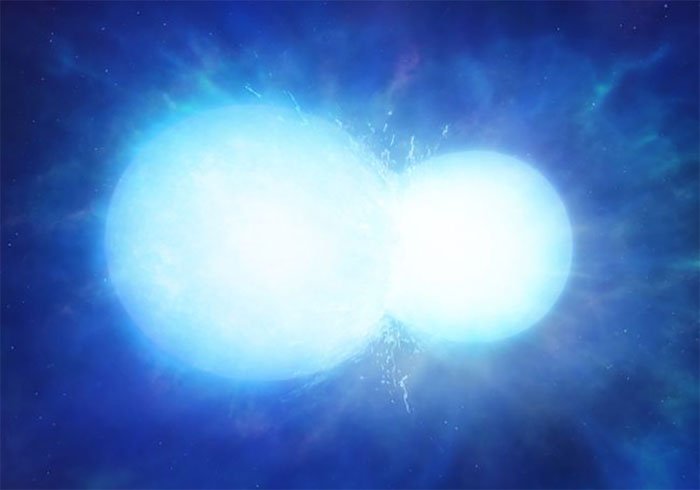Unusual white dwarf discovery: Formed by collision between two other white dwarfs
New research shows that the giant white dwarf WDJ0551 + 4135 may be formed by a collision between two other white dwarfs.
At the end of the life cycle, medium-mass stars run out of fuel and shed their outer layers, leaving the core to fade over time known as white dwarfs . They are extremely dense objects with each teaspoon of material weighing up to 4 billion tons, according to NASA.

Simulation of the collision that led to the birth of the white dwarf WDJ0551 + 4135. (Graphic: Mark Garlick).
Most white dwarfs are only as small as Earth but have a mass of 0.6 times the Sun. Our Sun will one day become white dwarfs like the other 90% of the Milky Way stars.
However, a recent study of the white dwarf WDJ0551 + 4135 , about 150 light-years from Earth, is challenging astronomers' understanding.
Observations from the European Space Agency's Gaia Telescope (ESA) show that this object is not only twice as heavy as ordinary white dwarfs (1.14 times the mass of the Sun), but also contains a vast amounts of carbon in the atmosphere, something unheard of before.
"White dwarfs often have an onion-like structure with many layers inside," said lead author Mark Hollands, an astrophysicist at the University of Warwick, UK. "Their core is mainly made up of carbon and oxygen. The outer layer is usually covered with a layer of helium and eventually hydrogen. When looking at white dwarfs with a telescope, we can only see the layer. outside".
However, in the case of WDJ0551 + 4135, Hollands and colleagues observed the mixture of carbon and hydrogen in the outer layer."This is really strange and incredible, raising a big question about the origin of this white dwarf star," Hollands stressed.
According to the team, WDJ0551 + 4135 could be formed after a collision between two other white dwarfs. They merge but have not exceeded the mass limit (1.4 times the mass of the Sun) to trigger a supernova explosion. The result is a new giant white dwarf with mixed layers of components.
Scientists estimate the merger happened about 1.3 billion years ago. The collision has raised the initial temperatures of the two white dwarfs, making it difficult to determine their age.
Few white dwarfs are known to be as massive as WDJ0551 + 4135. The new discovery could help scientists decipher their origin. Details of the study were published in Nature Astronomy today.
- What is a white dwarf?
- Strange planet death story helps bring life
- Stunned to discover the most exotic new white dwarf in the universe
- A white dwarf will explode in the next few million years
- Detecting a special twins NN Serpentis
- Video: The unification of two white dwarfs
- White dwarf missing in planetary nebula
- Amazingly explore the mysterious nature of brown dwarfs
- Identify the two oldest dwarfs in the universe
- See before the end of the earth
- Unbelievably unexpected about the new Milky Way galaxy's new neighbor
- Discovering the secret of life in brown dwarfs
 Van Allen's belt and evidence that the Apollo 11 mission to the Moon was myth
Van Allen's belt and evidence that the Apollo 11 mission to the Moon was myth The levels of civilization in the universe (Kardashev scale)
The levels of civilization in the universe (Kardashev scale) Today Mars, the sun and the Earth are aligned
Today Mars, the sun and the Earth are aligned The Amazon owner announced a secret plan to build a space base for thousands of people
The Amazon owner announced a secret plan to build a space base for thousands of people World's most expensive mushroom threatened by climate change
World's most expensive mushroom threatened by climate change  Astronomers unexpectedly discover a completely new phenomenon in outer space
Astronomers unexpectedly discover a completely new phenomenon in outer space  A star will explode in 2024, visible to the naked eye
A star will explode in 2024, visible to the naked eye  The rarest animal on the planet, there are only 2 individuals left in the world
The rarest animal on the planet, there are only 2 individuals left in the world  Animals humans have never seen the process of giving birth
Animals humans have never seen the process of giving birth  Vietnam has a precious plant rich in vitamin C, which helps control blood sugar and nourish the liver effectively
Vietnam has a precious plant rich in vitamin C, which helps control blood sugar and nourish the liver effectively 